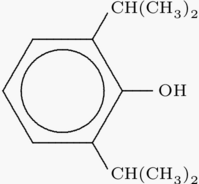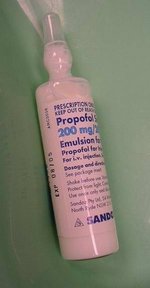To the Editor:
It was with great interest that we read the letter from Dr. Langevin (October 1999) regarding the sulfite content of propofol.[1] Dr. Langevin states that when the generic formulation of propofol (Gensia; Irvine, CA) is given at the maximum labeled dosage of 50 [micro]g/kg/min, the sodium metabisulfite (SMBS) exposure approaches the median lethal dose for rats (125 mg/kg). Assuming that a 70-kg patient receives 50 [micro]g/kg/min of the generic propofol for 24 h, the actual exposure to the patient of SMBS would be a total of 126 mg/d. This dosage of 126 mg/d of SMBS would actually only be 1.8 mg/kg, 70 times less than reported by Dr. Langevin. This level of sulfite exposure would seem to support the conclusion of the US Food and Drug Administration (FDA) that "the substitution of sodium metabisulfite for EDTA [ethylenediaminetetraacetic acid] as an excipient in propofol injection emulsion does not effect the safety profile of the product."[2]
If the total amount of sulfite exposure is of concern, there are several amino acid preparations, utilized in total parenteral nutrition solutions, that provide a much higher level of sulfite. Examples of such products would range from Novamine (Clintec Nutrition; Deerfield, IL), which provides SMBS at approximately 450 mg/d (6.4 mg/kg for a 70-kg patient), to Amionsyn-PF (Abbott; Abbott Park, IL), which provides sodium hydrosulfite at 3,450 mg/d (49 mg/kg for a 70-kg patient).
Dr. Langevin also states that there are only two agents currently being used by anesthesiologists that are sulfite-containing products. In actuality, there are several more sulfite-containing products, including meperidine injection (Elkins-Sinn; Philadelphia, PA), norepinephrine injection (Levophed; Sanofi-Winthrop; New York, NY), and phenylephrine injection (Neo-Synephrine; Sanofi-Winthrop), that are commonly used by anesthesiologists.
The issue of whether SMBS should be used as an excipient in pharmaceutical products is unclear. Until the FDA makes a definitive decision, the actual exposure from replacement products that contain sulfite should be assessed based on appropriate estimations of exposure and compared with currently available products that are being utilized frequently.
Jonathan E. Lakamp, PharmD, BCPS St. Luke's Hosptital Chesterfield, MO
Paul P, Dobesh, PharmD, BCPS St. Louis College of Pharmacy St. Louis, MO
Correspondence to: Jonathan E. Lakamp, PharmD, BCPS, Assistant Director of Pharmacy-Clinical Services, St. Luke's Hospital, Department of Pharmacy, 232 S. Woods Mill Rd, Chesterfield, MO 63017; e-mail: lakaje@stlo.smhs.com
REFERENCES
[1] Langevin PB. Propofol containing sulfite-potential for injury [letter]. Chest 1999; 116:1140-1141
[2] Propofol generic clears FDA with excipient differing from Diprivan. FDC reports: the pink sheets 1999; 61:38
COPYRIGHT 2000 American College of Chest Physicians
COPYRIGHT 2000 Gale Group




